Windows and Dialog Boxes
Lobby Window
The Lobby window allows you to manage service providers that send information that can be received in the Lobby widget on the home page of the Suite application.
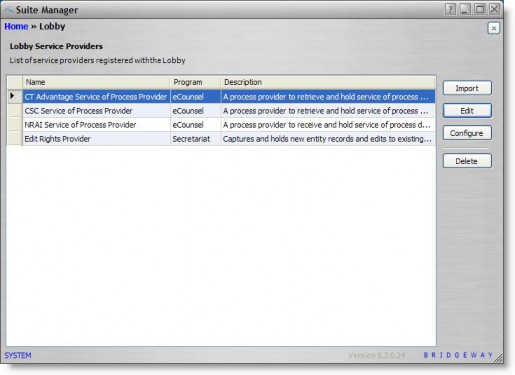
Fields
Name – The name of the service provider.
Program – The name of the Suite application for which the service provider is supplying data.
Description – A freeform comment concerning the service provider.
Buttons
Import – Click to open a dialog box from which to select an eXtensible Markup Language (XML) or script (BSI) file containing the service provider definition to be imported.
Edit – Click to modify the service provider description.
Configure – Click to open the Service Provider Configuration dialog box to specify information.
Delete – Click to remove the service provider definition from the system.
Service Provider Configuration Dialog Box
The Service Provider Configuration dialog box allows you to configure properties for service providers that send information that can be received in the Lobby widget on the home page of the Suite application.
Schedule Tab
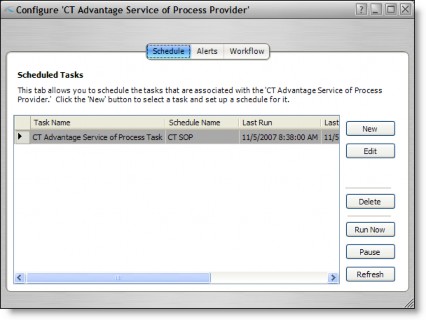
Task Name – The name of the task to import data from the service provider. Service providers use monitors to import data.
Schedule Name – The name of the schedule used to periodically import data from the service provider.
Last Run – The date/time the task was last executed and any data was imported from the service provider.
Last Success – The date/time the task was last executed successfully.
Next Run – The date/time the task will be run next.
Status – The status (such as Paused) of the scheduled task.
Alerts Tab
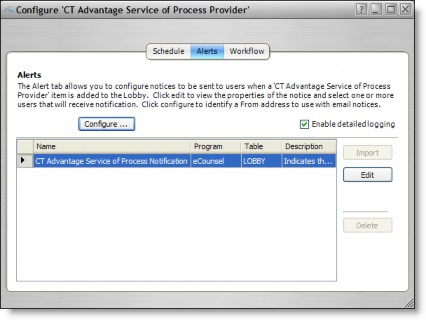
Configure button – Click to open a dialog box to specify the e-mail address from which the Lobby notice will be sent. Any e-mail address may be used, including an e-mail address that does not exist. Using a descriptive e-mail address, such as LobbyNotice, that does not exist ensures that users cannot reply to the address.
Enable detailed logging – An indication of whether the logs created for alerts contain more extensive descriptive information.
Name – The name of the type of Lobby notice.
Program – The name of the Suite application for which the Lobby notice applies.
Table – The name of the table in the database to which the Lobby notice applies.
Description – A comment concerning the purpose of the alert.
The Import and Delete buttons are not available because the service provider definition includes the needed alert definition, which cannot be deleted. New alert definitions cannot be imported on this dialog box.
Workflow Tab
This tab is reserved for custom workflow rules that can be requested by clients as a service.
Buttons
New – Click to open the Schedule Information dialog box to create a schedule for a task.
Edit – On the Schedule tab, click to open the Schedule Information dialog box to modify the schedule used to run the selected task. On the Alerts tab, click to open the Alert Profile Information dialog box to select users that will be e-mailed with information for the Lobby notice.
Delete – Click to remove the selected scheduled task.
Run Now – Click to execute the task immediately.
Pause/Resume – Click to temporarily stop/start execution of the task.
Refresh – Click to redraw information on the window.
Alert Profile Information Dialog Box
The Profile Information dialog box allows you to view the properties of a rule and assign users to the rule.
Properties Tab

Name – The name of the alert.
Description – A freeform comment concerning the alert. This text will display in the e-mail alert.
Program – The name of the Suite application for which the alert applies.
Table – The name of the table in the database to which the alert applies.
Version – The version number of the rule.
Disabled – An indication of whether the rule is currently active or inactive. Disabled rules appear on the Rules Engine window with a strikethrough font.
Parameters – Any parameters that are required for the rule.
Users Tab
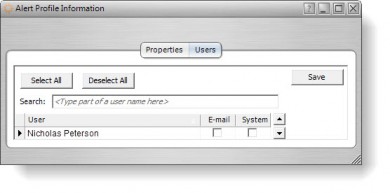
Search – The text for which you want to search.
User – The users that may have this rule applied.
E-mail – Click to indicate the user will be notified by e-mail.
System – Click to indicate the user will be notified by an alert in a widget on the user’s home page.
For the Approver E-mail Notification task only, selecting a user means that the user will not have the rule applied.
Buttons
Save – Click to save changes to the dialog box.
Select All – Click to select all checkboxes on the tab.
Deselect All – Click to de-select all checkboxes on the tab.
Schedule Information Dialog Box
The Schedule Information dialog box allows you to create the criteria by which Suite Manager will execute a task on a regular basis.
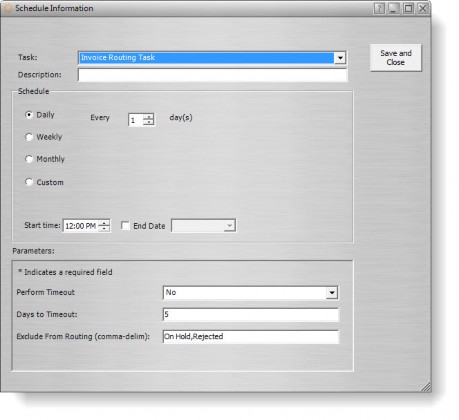
Fields
Task – The name of the task being scheduled.
Description – A freeform comment concerning the schedule.
Schedule – The basis on which Suite will determine how often to run the task.
Daily – If the task will be run on a daily basis, specify how many days between runs.
Weekly – If the task will be run on a weekly basis, specify the day(s) on which the task will be run.
Monthly – If the task will be run on a monthly basis, specify the day of the month on which the task will be run.
Custom – If the task will be run on a custom basis, specify the schedule used to determine when the task will be run.
Start time – The time at which the task will be run. This field is applicable to daily, weekly, and monthly schedules.
End Date – The date on which the schedule will be terminated for the task.
Parameters – Any parameters that must be set for the task.
Buttons
Save and Close – Click to save the new filter or changes to the filter.

